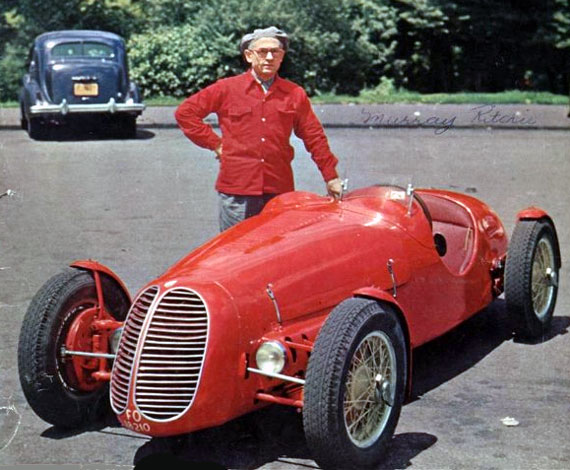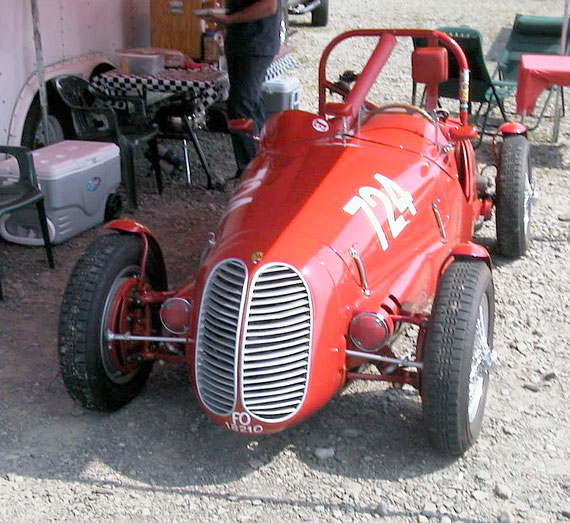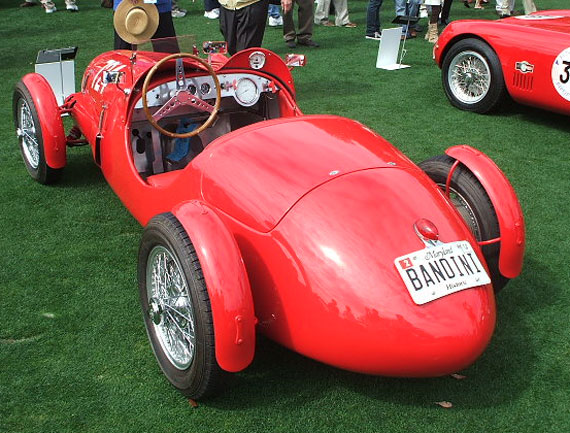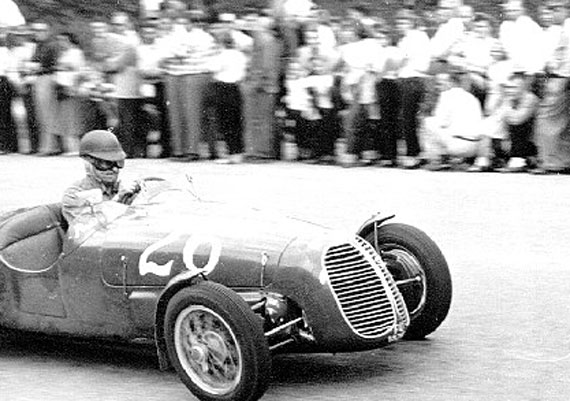
January 1952 Motorsport cover. The Bandini powered by a 1100cc Fiat engine finished 10th at Elkhart Lake, owned by Tony Pompeo, New York. With car is Perry Fina. Photo by Bill Finn.
Story by John Wright
The neat little cycle-fendered sports car pictured here is one of a few Bandinis which were exported to the U.S.A. in the immediate post war era. Their creator, Ilario Bandini was born in Forli, Italy, and because he was mechanically inclined, set himself up as a creator of sports cars using Fiat parts only as the basis of his pretty and slinky designs in coupes, roadsters and race cars.
Primarily, he used – as many Italian specialty sports car builders did – Fiat parts, including highly tuned Fiat 750cc engines in his cars, but he also used Crosley engines with their overhead camshafts, and he frequently replaced the original heads with his own DOHC heads. His glory years were in the early 1950s when he turned out around fifteen cars; obviously, Bandini was never a mass producer of sports cars. By 1960, he had turned out perhaps seven different stages of motors with displacements varying from the aforementioned 750cc to 1300 cc. The jewel like and miniature, by North American standards, 750cc engined cars could reach speeds of around 100 mph.
The Bandini pictured here looks as if it has been modified from when it was first raced. In the interests of safety, the owner has had to install a roll bar, thus sullying the smooth and classic tail end of the car, or so one would think. Not so! He constructed an aluminum deck lid and put the original in storage to maintain its pristine nature.
I checked it with a European expert on the history of the rare Bandini marque, and he supplied me with some interesting facts on not only the Bandini but also on Ilario Bandini. What we must remember about Italian marques from the late 1940s and into the 1950s is that just about every automobile oriented garage especially in the north of Italy was populated by people who wanted to be the next Enzo Ferrari or the Maserati brothers, that is builders of what might become the next Formula One car or the next world beating sports racing car. Surely Ilario Bandini fit into that mold. Here the story begins.
The car (in the photo which accompanies this article) carries the same registration number and nearly the same bodywork as the very first Bandini built. However, this is the third Bandini to be constructed. The car was produced in 1949, using a tube frame chassis with Caproni (An Italian airplane company) derived pieces and according to the late llario Bandini the engine was an old Fiat 1100cc engine with an Alfa Romeo six cylinder unit “bialbero’ head (Twin camshaft) adapted on the Fiat base, chopping the 3rd and 4th cylinder area and by welding it all around.
Local tuner of engines, Oberdan Golfieri is said to have collaborated with the engine project. Bandini himself with the help of Erminio Bondi (who also created his own limited series of sports cars) created the “siluro” bodywork. All that is certain about the car’s competition history is that the car made its debut at the 1949 Mille Miglia but the car was withdrawn. The car withdrew from the race at the Circuito di Ferrara with Bandini at the wheel, and the one and only result in 1949 was a ninth in class and 14th overall at Pescara. The car was fielded also in 1950, but it was somewhat modified and a more normal Fiat 1100 cc unit was installed.
By pure chance, Ilario Bandini met two Italo-Americans, Tony Pompeo and Perry Fina, who at the end of the 1950 season purchased the car and exported it to the USA, selling it to Dick Gent from Cincinnati who raced it for a couple of seasons before selling the car to Ed White. In 1959, Bill King bought the car, and his son is the owner today.
On track, at Watkins Glen, the little Bandini was not going to intimidate the V-8 powered Allards and Listers, but it could show a fleet set of heels to some of the Sprites and some of the older MG series cars.
It was the irrepressible nature of Italian car builders which was to keep the cottage industry of race car and sports car builders alive in Italy, but the mass produced sports car was something foreign to the nature of these pioneers. The American concept of the assembly line was anathema to them. They reveled in their handcrafted one of -a -kind designs, and they loved their Fiat and Alfa Romeo engines, as North American specialty car builders loved the Ford Flathead V-8 and the early versions of Detroit overhead valve V-8s, like the Cadillac and Chrysler Hemi head engines. There were many of these builders pounding out metal and aluminum in Italy, and when the small bore sports car turned out to be a blind alley, they went on to something else in the late 1950s: the Formula Junior race car. However, that’s another story.
Thanks to Cliff Reuter for his help on this story; be sure to see more about the car on his website www.etceterini.com



Pete:
That Bandini on the cover–Fina in red shirt and red car–,made big impression to this 14 year old enthusiast. Hell, even remember the kindly man at local Pharmacy that sold me the magazine.! MOTOR SPORT offered cars that you would not see elsewhere. 40 Years later had pleasure to speak with Mr Gents son about his fathers Italian machines
Cover car was real favorite until later in 1952 the 1st OSCA arrived on the West coast and driven by screen writer Randy Mac Dougall. With a mere 1100cc motor
and high price tag, the car impressed most everybody on that day at Torrey Pines.
Jim Sitz
G.P. Oregon
Veloce Today —
Thanks to John Wright for bringing us the nicely-titled story of “The King’s Bandini.” There are a couple of additions and corrections that are little-known and hard to find. The Bandinis, like Siatas, were made in three sizes: mama bear, papa bear and baby bear — that is, 750cc, 1100cc and 1400cc, neatly fitting the SCCA classes H-Modified, G-Mod and F-Mod. While the subject of Mr. Wright’s story is the 1100cc, the most prominent of these early Bandinis were the other sizes, the 750cc of Mel Sachs and the 1400cc Siata-engined car of Jim Pauley. The reason this is so is that the 1100 class was dominated by John Bentley’s Siata and later by Rees Makin’s OSCA. I can’t speak for the G-Mod cars, but in H-Mod the Bandini was about 800 lbs vs. the 1000 pound Siata, so it was faster but it did not handle as well (virtually nothing did). One of the distinctive features of the Bandini was its elliptical frame tubes, welded in an “upright” orientation, which made it lighter and stronger at the same time. Dick Gent, who was the first American owner of the 1100cc Bandini, was from Cleveland, not Cincinnati, as is his son Richard Gent Jr, a prominent and enthusiastic car collector. I hope you don’t mind my nit-picking and thanks again for writing about these appealing little cars. — Carl Goodwin
Thanks to Carl Goodwin for straightening out some nits and picks from the story. I want to learn more about those little Etceterinis as they have a racing past in Canada as well as more prominently in the USA.
Cheers,
John Wright
Thankyou Jhon Wright, Jim Sitz, look for me in facebook, please.
Bandini Automobili page or my personal one
cheers
Michele Orsi Bandini